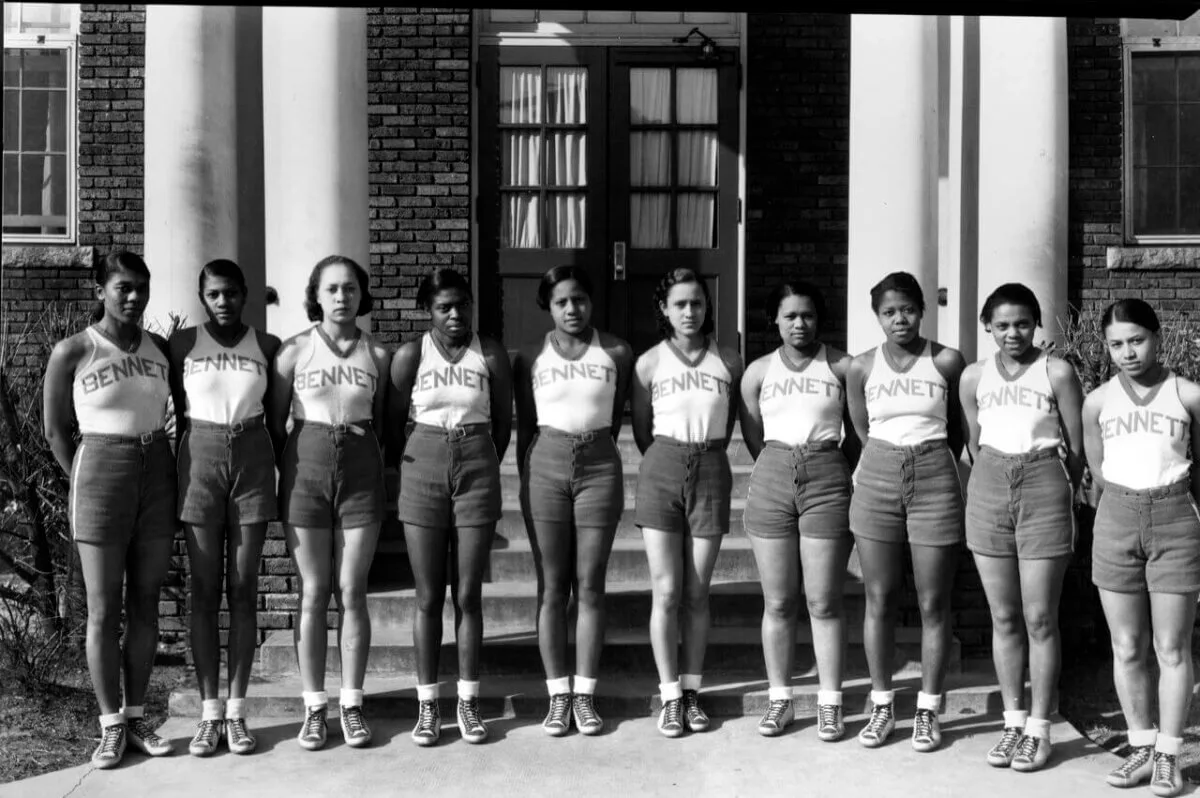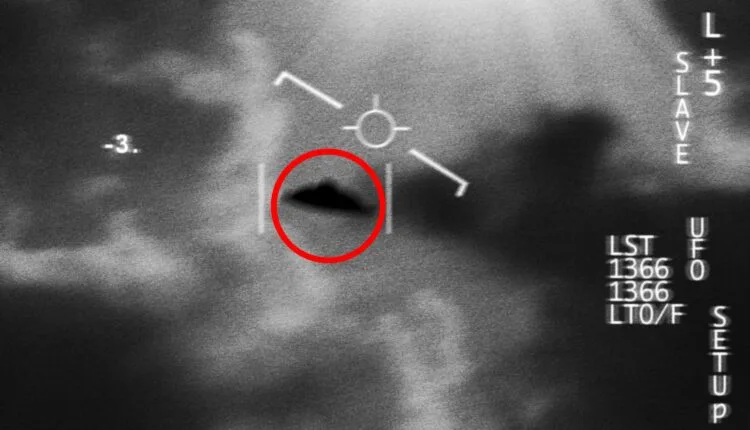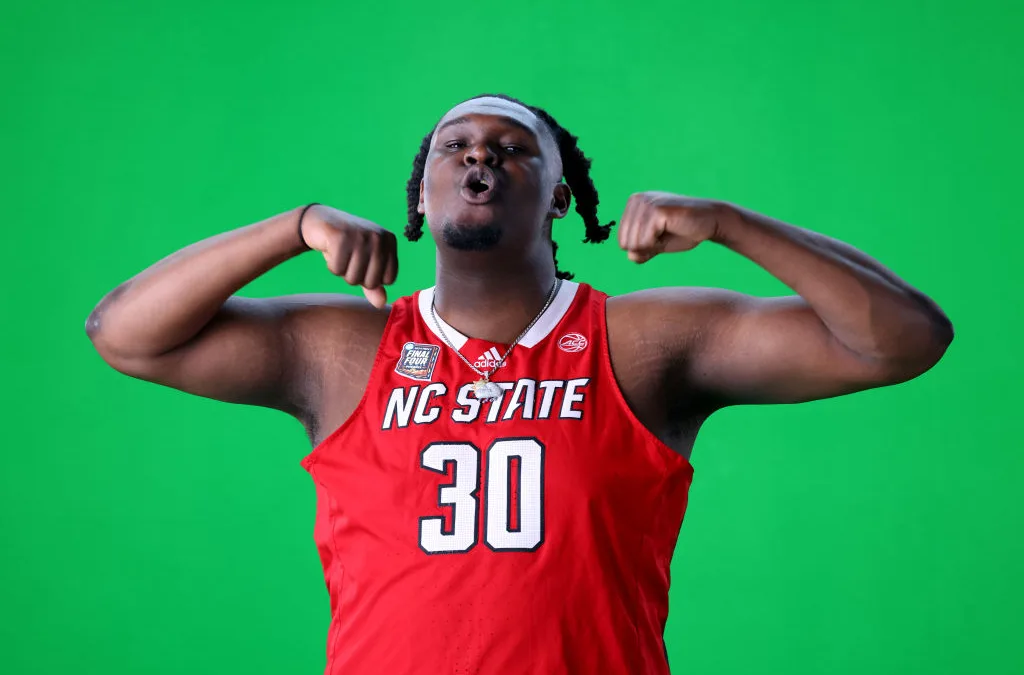
Bennett College team, Greensboro, North Carolina, 1934. Ruth Glover is third from left. (Courtesy of the Greensboro Historical Museum.)
A new podcast on the life of the great Ora Washington is reviving interest in the Jim Crow era of women’s sports, including a 1934 matchup between NC’s Bennett College and the best Black women’s team in the nation.
It was March 12, 1934, and more than a thousand spectators filled the stands of Greensboro’s Sports Arena, eagerly awaiting one of the most celebrated basketball contests the city had ever seen.
The Philadelphia Tribunes had come to town.
Sponsored by Philadelphia’s Black newspaper, and starring the phenomenal Ora Washington, the professional Tribunes were the best Black women’s team in the nation.
Excitement over their visit ran so high that the contest with the powerhouse team from local Bennett College was covered in Black newspapers across the country, and in the white Greensboro Daily News.
“After having met and defeated in rapid succession all of the college teams that would accept to play,” the Daily News article ran, “the undefeated Bennett College team, seeking larger worlds to conquer, will risk its reputation against Otto Briggs’ Tribune female team,” led by “the indomitable, internally famed and stellar performer, Ora Washington.”
On the appointed night, a large, racially mixed crowd filled the arena.
“It was full . . . there were four sections and when they got filled up they had to lock the doors and have cops stationed outside,” one Bennett player recalled. “It was the largest place we had ever played in.”
Spectators were not disappointed. The Tribunes matched their flashy play with flashy outfits, appearing in red and white for the first half, and purple and gold for the second, “with socks to match.” The play was fierce.
In the words of the Atlanta Daily World, the “gallant, fighting, powerful” Bennett team “went down to defeat before a better, more experienced, and versatile aggregation of assured fast stepping, clever passing, and close guarding ball tossers.” The final score: Tribunes, 31 – Bennett, 22.
In subsequent years, however, the teams that had caused such a stir faded from view.
Leaders of many institutions, both Black and white, had always viewed basketball as an unladylike sport, unsuited to the development of “finer womanhood.” Over time, that influence spread. Bennett fielded its last varsity squad in 1941. The Tribunes disbanded the next year, following the death of key sponsor Otto Briggs.

Loss and Recovery
Following World War II, a national resurgence of conservative gender divisions sparked the rise of female cheerleading, but further undercut women’s sports, especially basketball. By the 1960s few competitive women’s teams remained. The stars of the 1920s and 1930s slipped into obscurity.
In 1976, the founders of the Black Athletes Hall of Fame decided to honor Ora Washington, who had dominated Black tennis as well as basketball, and they launched an unsuccessful search to find her. They did not know that she had died five years before.
Happily, interest in the sporting cultures of the Jim Crow era has revived, and the remarkable accomplishments of Black female athletes such as Serena Williams and the stars of the WNBA have prompted new research into Black women’s sporting history.
The Bennett-Tribunes game comes to life again this week in the latest episode of “Untold Legends: Ora,” the terrific BBC podcast about Ora Washington’s life.
As well as uncovering forgotten sports stories, revisiting the age of segregation highlights the remarkable culture of North Carolina’s historically Black colleges, especially the multifaceted womanhood they nurtured.
Bennett College was a prime example of these efforts. Graduates of the private, all-female Methodist school were famed for their refined taste and manners and were often dubbed the Bennett Belles.
But the social, political and economic challenges faced by African American communities meant that Black women had to do far more than serve tea and organize charity events. As a result, Bennett students and administrators shaped a flexible vision of womanhood that encouraged women to be competitive and assertive in certain situations, restrained and proper in others.
“We were ladies,” explained Bennet star Ruth Glover, who hailed from Siler City, N.C. “We just played basketball like boys.”

Bennett faculty carefully guarded their school’s reputation as the “Vassar of the South,” and demanded excellence in every realm of college life. Sports was no exception. Bennett students observed study hours from 7 to 9 every night, and basketball practice started after that, running from 9 until 11.
On Saturdays, coach William Trent often arranged for his players to scrimmage against the boys’ team from nearby Dudley High School. He set strict standards for discipline and effort. “If you in any way showed any sign of not following instructions, and so forth, he would bench you,” Glover recalled. “He would call you off that team and sit you down for a while. Until you would straighten yourself out.”
That hard work produced players who were disciplined and determined. Amaleta Moore, from Cape May, N.J., found her niche as a defensive specialist.
“I played guard,” she explained. “I had long arms—I was a good-sized girl. So my interest was in keeping the forward from shooting. And that I would do. As Bill Trent used to tell me: ‘Go in there Amie and stop her.’ And I enjoyed it. I used to get down and put my hands on my knees and get a squat stance. And they’d hit me—I didn’t move.”
Her most memorable moment came the night she stopped Shaw star Frazier Creecy, a hard-nosed, wily competitor.
“She would dance like she was going that way, and you looked and she was going around this way,” Moore recalled. “She would throw the other guards off—they couldn’t keep up with her.”
If someone did get between her and the basket, “she came with that hair flying – she’d come straight for you.”
One night when Creecy was tearing up the floor Trent turned to Moore and told her to do something. Moore trotted to the court, determined to succeed.
“I said: ‘I will brace myself and let her come,’” she explained. “And I stood there and she dribbled straight at me. She hit me, and I didn’t move. She fell back on the court—you heard her bones crack when she hit the floor—and they took her off on the stretcher. . . . I didn’t hit her or anything. I just stood there, but I braced myself first, because I knew she was going to do it. I said: ‘She’ll never run over me.’”
Ruth Glover, in contrast, was a shooter who regularly hit the basket from half-court and who impressed the Philadelphia Tribunes’ coach so much that he tried to convince her to leave school and join the Tribunes on the spot.
“I could tell exactly when that ball left my hand whether it was the right shot or not, whether it was going or not,” she explained. “It’s a feel that you just have . . . There’s an inner voice, if you just take time to listen to it, you know.”
Glover had arrived at Bennett as “a little country girl,” intimidated by her new surroundings. “I was a little shy at first,” she explained. “A little shy and withdrawn. I was not an outgoing person.” Basketball stardom “gave me some confidence in myself. That I could accomplish. And even the president would make you feel good. I know when I would return to campus in the fall, he’d say: ‘Oh, we’re going to have some basketball this year!’ Things like that. He liked to kind of push girls, you know what I mean. He was behind you in whatever you wanted to do. He would follow you through and was enthusiastic about all of those things. That helped you to get confidence in yourself.”
More Than A Game
As well as nurturing individual strengths, basketball played a key role in players’ understanding of community – a central component of Black college life.
“The whole idea was to go and contribute to the community where you lived,” Moore explained. “You were training for a given profession so that you could go back and contribute.” Amid the obstacles raised by poverty and discrimination, pursuing such endeavors required economic savvy, political skill and organizational ability, as well as energy, creative thinking, determination and confidence. Sports built those qualities while forging the emotional connections that helped communities work together. “You felt a sense of worth, and a feeling of security,” Moore continued. “You learned something about the value of support from your community, from other people. So that you don’t have this blown-up idea that you’re so important. . . . You have that support and you support [others] in the same way.”
For young Black women navigating the challenge of Jim Crow, the expansive spirit nurtured by athletic expression could spill over into other arenas. The Bennett team traveled to its matches in the chauffeured Cadillac of Bennett president David Jones.
“We would be riding along the highway and you’d meet some white fellows thumbing,” Moore laughed. “And we’d hang our heads out the window and say: ‘Jim Crow car!'”
When I first looked into the history of Black women’s basketball, back in the 1990s, researchers had to search far and wide for information. We shared tips and stories, made trips to institutions to read documents and scroll through microfilm, tracked down players and descendants largely through word of mouth. It was an enjoyable, but somewhat lonely task.
It’s so exciting to see these stories come alive again, and start reaching the broad audience they deserve. There’s plenty more to learn. I look forward to many more years of revelation.
[Quoted material comes from oral history interviews conducted by Pamela Grundy and Rita Liberti. Grundy’s interview with Ruth Glover Mullin and Amaleta Moore is available in the archives of the Southern Oral History Program, Wilson Library, UNC Chapel Hill. More information on women’s basketball history, including North Carolina teams, coaches and players, can be found in Shattering the Glass: The Remarkable History of Women’s Basketball, co-written by Grundy and Susan Shackelford, from which parts of this article have been taken.]
Politics

Op-ed: Michele Morrow poses a huge threat to NC public schools
Students with disabilities would particularly suffer if Michele Morrow were to become the state Superintendent of Public Instruction, Susan Book...

Biden makes 4 million more workers eligible for overtime pay
The Biden administration announced a new rule Tuesday to expand overtime pay for around 4 million lower-paid salaried employees nationwide. The...
Local News

The 5 most believable UFO sightings ever reported in North Carolina
Read about five alien encounters that may forever remain unexplained. When you think of the most common places where you might hear a UFO sighting...

Good News Friday: It’s a good day to be a fan of the NC State Wolfpack
The men's and women's teams will compete for a national championship in college basketball this weekend. Plus: How to watch the solar eclipse, and...




